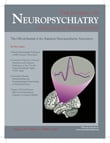Low Dose Alpha-Methyl-Para-Tyrosine (AMPT) in the Treatment of Dystonia and Dyskinesia
Intracellular Dopamine
Phosphorylation of Tyrosine Hydroxylase
Case Studies Using Low-Dose AMPT
Case 1. Constant Tremor and Intermittent Dystonia Secondary to Brain Trauma
Case 2. The Use of AMPT to Mask Acute Tardive Dystonia
Case 3. Relief of Symptoms of Long-Standing Tardive Dyskinesia Using a Very Low Dose of AMPT
Clinical Experience With Dopamine-Depleting Drugs
Side Effects
Effect of Chronic Antipsychotics on Tyrosine Hydroxylase Function
The Unique Pharmacology of AMPT
Footnote
References
Information & Authors
Information
Published In
History
Authors
Metrics & Citations
Metrics
Citations
Export Citations
If you have the appropriate software installed, you can download article citation data to the citation manager of your choice. Simply select your manager software from the list below and click Download.
For more information or tips please see 'Downloading to a citation manager' in the Help menu.
View Options
View options
PDF/EPUB
View PDF/EPUBGet Access
Login options
Already a subscriber? Access your subscription through your login credentials or your institution for full access to this article.
Personal login Institutional Login Open Athens loginNot a subscriber?
PsychiatryOnline subscription options offer access to the DSM-5-TR® library, books, journals, CME, and patient resources. This all-in-one virtual library provides psychiatrists and mental health professionals with key resources for diagnosis, treatment, research, and professional development.
Need more help? PsychiatryOnline Customer Service may be reached by emailing [email protected] or by calling 800-368-5777 (in the U.S.) or 703-907-7322 (outside the U.S.).

